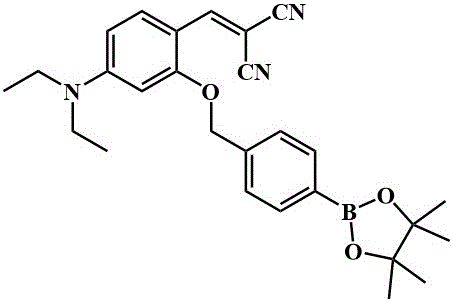Preparation and application of hydrogen peroxide fluorescent probe compound
A fluorescent probe and hydrogen peroxide technology, applied in the field of fluorescent probes, can solve the problems of short hydrogen peroxide existence time, few types of hydrogen peroxide probes, and interference in hydrogen peroxide detection, achieving high selectivity and good Effect of sensitivity and selectivity, good water solubility
- Summary
- Abstract
- Description
- Claims
- Application Information
AI Technical Summary
Problems solved by technology
Method used
Image
Examples
Embodiment 1
[0045] Embodiment 1, the synthesis of probe molecule I
[0046] (1) Take 1.613 grams of 4-diethylaminosalicylaldehyde, 1.38 grams of bromobenzyl bromide, and 0.533 grams of anhydrous potassium carbonate in a three-necked flask under nitrogen protection. Add 13 ml of acetone into the flask; stir at 50°C Refluxed overnight, evaporated the solvent, and used ethyl acetate:petroleum ether volume ratio of 1:4 as the developing solvent, and separated through the column to obtain 1.004 g of pure product II with a yield of 53%.
[0047] (2) Dissolve 0.339 g of II, 0.285 g of pinacol diborate, and 82 mg of [1,1-bis(diphenylphosphino)ferrocene]palladium dichloride in 10 ml of dry DMF, and dissolve them at 80°C Nitrogen protection was refluxed overnight, the solvent was distilled off, and the compound solvent with a volume ratio of petroleum ether:ethyl acetate of 1:1 was used as a developing solvent, and the compound was separated through a column to obtain 0.369 g of Compound III with...
Embodiment 2
[0049] Embodiment 2, fluorescence experiment
[0050] Take the fluorescent probe compound prepared in Example 1, dissolve it in an aqueous solution containing 5% acetonitrile, and adjust the pH to 7.4 with HEPES buffer solution; obtain a fluorescent probe solution for future use.
[0051] 1. Take the fluorescent probe solution and divide it into 12 groups, 10 ml in each group. Among them, 1 group does not add reactive oxygen species, and 11 groups add CH 3 COOOH, GSH, H 2 o 2 , HOCl, NO, O2•-, •OH, ONOO-, otBU, TBHF, Vc solutions, so that the concentration of the probe compound contained in each group of solutions is 10 micromolar, and the concentration of active oxygen species is 300 micromolar, so that the active oxygen The molar ratio of the species to the probe compound is 30:1; the excitation wavelength is 437 nm, and the fluorescence intensity is tested by a fluorescence photometer, as figure 2 As shown, the results show that the probe solution of the present invention ...
Embodiment 3
[0053] Embodiment 3, cell imaging experiment
[0054] MCF-7 cells were cultured in 1 milliliter of cell culture medium containing 10% bovine fetal serum for 12 hours, then treated with 100 micromoles / liter of fluoride ion for 10 minutes, and then treated with 10 micromoles / liter of the fluorescent probe of the present invention Process for 30 minutes. Cells were excited with a light source with an excitation wavelength of 437 nm and imaged under a confocal microscope. Figure 4 It is an imaging diagram of MCF-7 cells cultured with the fluorescent probe of the present invention and hydrogen peroxide.
PUM
 Login to View More
Login to View More Abstract
Description
Claims
Application Information
 Login to View More
Login to View More - R&D
- Intellectual Property
- Life Sciences
- Materials
- Tech Scout
- Unparalleled Data Quality
- Higher Quality Content
- 60% Fewer Hallucinations
Browse by: Latest US Patents, China's latest patents, Technical Efficacy Thesaurus, Application Domain, Technology Topic, Popular Technical Reports.
© 2025 PatSnap. All rights reserved.Legal|Privacy policy|Modern Slavery Act Transparency Statement|Sitemap|About US| Contact US: help@patsnap.com



